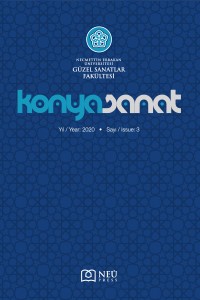Konya Alâeddin Camii Mihrap Yüzeyindeki Selçuklu Sülüsü Yazıların Hat Sanatı Açısından Değerlendirilmesi
Öz
Anahtar Kelimeler
Kaynakça
- Akok, M. (1972). Anadolu Selçuklu Mimarisinde, Geleceğin Türk Sanatına Kaynak Olan Varlıklar, Ankara.
- Derman, U. (1987). “Hat”,Türkiye Diyanet Vakfı İslam Ansiklopedisi, C.16, İstanbul.
- Erdemir, Y. (2009). Karatay Medresesi Çini Eserleri Müzesi, Konya.
- Erikoğlu, B. (2009). Selçuk Üniversitesi Sosyal Bilimler Enst. Yayımlanmamış Yüksek Lisans Tezi, Konya’da Selçuklu Dönemi Yapı Kitabelerinin (İnşa-Tamir) Hat San’atı Bakımından Değerlendirilmesi. Konya.
- Erzincan, T. (1989). “Mihrap”, Türkiye Diyanet Vakfı İslam Ansiklopedisi, C.30, İstanbul.
- Eyice, S. (1989). “Alaeddin Camii” Türkiye Diyanet Vakfı İslam Ansiklopedisi,C.2, İstanbul.
- Gün, R. (1999). Ondokuz Mayıs Üniversitesi Sosyal Bilimler Enst. Yayımlanmamış Doktora Tezi, Anadolu Selçuklu Mimarisinde Yazı Kullanımı, Samsun.
- Günüç, F. (1996). “Anadolu Selçuklu Mimarisinde Celî Sülüs Hattı”, V.Milli Selçuklu Kültür ve Medeniyeti Semineri Bildirileri (25–26 Nisan 1995), Konya.
- Konyalı, İ.H. (1964). Abideleri ve Kitabeleriyle Konya Tarihi, Konya.
- Öney, G. (1992). Anadolu Selçuklu Mimari Süslemesi ve El Sanatları, Ankara.
- Önge, Y. (1966). Türk Çinicilik Sanatından Enteresan Örneklerinden İbrahim Bey İmareti Mihrabı, Arkitek, İstanbul.
Öz
Writing, which is one of the most important tools connecting the past to the present, has gained great importance with the advent of Islam. The Quran verses Hz. Muhammed With the encouragement and appreciation of the Prophet, the art of writing, which has improved with the initiation of writing, has become an art on its own by the hands of Muslim states and finally with the contributions of our ancestors. This art of ours, called calligraphy, has been used in religious and architectural works as well as book arts. Mosques are undoubtedly one of these architectural works. In the sash parts surrounding the interior of the mosques, verses and hadiths were written in appropriate places such as dome, mihrab, mimber, door and window pediments, and the congregation that filled these mosques for centuries was inspired by divine orders. In this study, a study was carried out on the tile altar of the Alâeddin Mosque in Konya, our ancient city, the capital of Seljuk. The inscription written in the style of Seljuk thuluth on the surface of the ceramic mihrab, which was destroyed in the past, was evaluated in terms of calligraphy and the post-writings on the damaged plaster parts of the mihrab were rewritten in a way that resembles the writings on the original tile part, contributing to the renovation of the altar.
Anahtar Kelimeler
Alâeddin Mosque Mihrab Seljuk Thuluth Calligraphy Hüsn-i Hat
Kaynakça
- Akok, M. (1972). Anadolu Selçuklu Mimarisinde, Geleceğin Türk Sanatına Kaynak Olan Varlıklar, Ankara.
- Derman, U. (1987). “Hat”,Türkiye Diyanet Vakfı İslam Ansiklopedisi, C.16, İstanbul.
- Erdemir, Y. (2009). Karatay Medresesi Çini Eserleri Müzesi, Konya.
- Erikoğlu, B. (2009). Selçuk Üniversitesi Sosyal Bilimler Enst. Yayımlanmamış Yüksek Lisans Tezi, Konya’da Selçuklu Dönemi Yapı Kitabelerinin (İnşa-Tamir) Hat San’atı Bakımından Değerlendirilmesi. Konya.
- Erzincan, T. (1989). “Mihrap”, Türkiye Diyanet Vakfı İslam Ansiklopedisi, C.30, İstanbul.
- Eyice, S. (1989). “Alaeddin Camii” Türkiye Diyanet Vakfı İslam Ansiklopedisi,C.2, İstanbul.
- Gün, R. (1999). Ondokuz Mayıs Üniversitesi Sosyal Bilimler Enst. Yayımlanmamış Doktora Tezi, Anadolu Selçuklu Mimarisinde Yazı Kullanımı, Samsun.
- Günüç, F. (1996). “Anadolu Selçuklu Mimarisinde Celî Sülüs Hattı”, V.Milli Selçuklu Kültür ve Medeniyeti Semineri Bildirileri (25–26 Nisan 1995), Konya.
- Konyalı, İ.H. (1964). Abideleri ve Kitabeleriyle Konya Tarihi, Konya.
- Öney, G. (1992). Anadolu Selçuklu Mimari Süslemesi ve El Sanatları, Ankara.
- Önge, Y. (1966). Türk Çinicilik Sanatından Enteresan Örneklerinden İbrahim Bey İmareti Mihrabı, Arkitek, İstanbul.
Ayrıntılar
| Birincil Dil | Türkçe |
|---|---|
| Bölüm | Araştırma Makaleleri |
| Yazarlar | |
| Yayımlanma Tarihi | 25 Aralık 2020 |
| Gönderilme Tarihi | 29 Ekim 2020 |
| Yayımlandığı Sayı | Yıl 2020 Sayı: 3 |
Necmettin Erbakan Üniversitesi Güzel Sanatlar ve Mimarlık Fakültesi
Adres: Köyceğiz Yerleşkesi Güzel Sanatlar ve Mimarlık Fakültesi Dekanlığı, Köyceğiz Mah., Demeç Sok., No:39/2 Meram /KONYA • E-posta: konyasanat@erbakan.edu.tr
Konya Sanat Dergisi Creative Commons Atıf-GayriTicari 4.0 Uluslararası Lisansı (CC BY NC) ile lisanslanmıştır.
e-ISSN: 2667-789X


